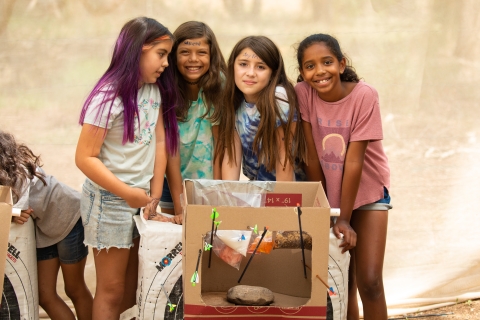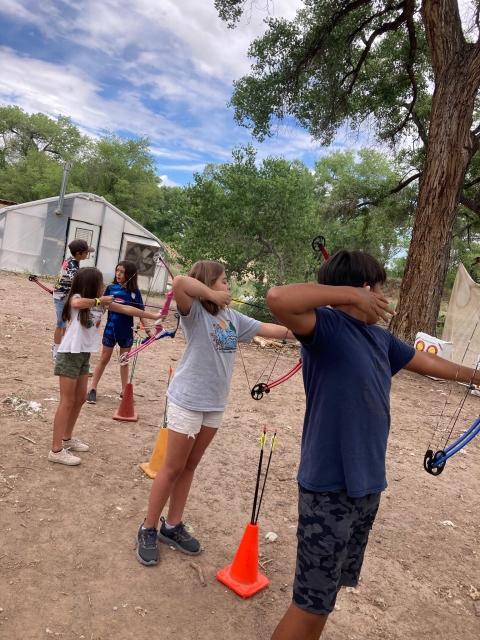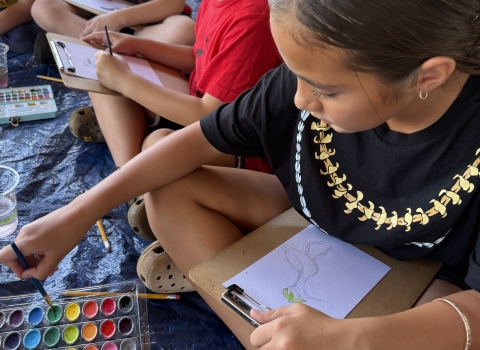The New Mexico Wildlife Federation's Nature Niños initiative has helped youth and families-across generations connect with nature. Nature Niños creates access to the outdoors by hosting a pay what you can summer camp for youth, field trips, art and nature exploration, and other conservation-based activities. Recently, Nature Niños has expanded their efforts through the new Mi Tierra Salvaje project which is funded through a Multistate Conservation grant from the U.S. Fish and Wildlife Service. Mi Tierra Salvaje, which translates to My Wild Land, is designed to introduce underserved communities to nature and spark a lifelong interest in outdoor recreation, including opportunities for fishing and hunting.
Started in 2019, Nature Niños is designed as an entry point to the outdoors with activities that build outdoor skills and grow the next generation of conservationists and land stewards. “It is not always easy to get outside, it might seem too far or unfamiliar to many,” said Sarah Candelaria,Youth Program Director at Nature Niños. “Being ‘nature nervous’ is real and that is why projects like Mi Tierra Salvaje are so important.” As part of the Mi Tierra Salvaje project, Nature Niños staff worked with other leading engagement organizations to identify the best practices to effectively engage youth and their families in hunting and angling - focusing on communities not historically involved in these activities. “For this project we reached beyond our own experiences and examined a variety and wealth of information,” added Candelaria. “We reviewed leading strategies in youth engagement, conducted a literature review, and hosted listening sessions with partner organizations to understand the challenges and opportunities to engage youth in fishing and hunting.”
Numerous barriers to participation in fishing and hunting were identified through the project. These barriers included cost, availability of adult supervision, and transportation and logistics. Areas suitable for fishing and hunting are not always easily accessible or close to urban centers increasing the difficulty to access sites for some communities. This is especially true for communities with poor access to public transportation and for households whose parents work during the scheduled programming. The perceptions of fishing and hunting were also highlighted as a potential barrier leading to uncertainty and concerns about safety for those unfamiliar with the activities.
Once the barriers were highlighted, Nature Niños got to work implementing potential solutions, such as creating strong community partnerships, expanding transportation access, focusing on bilingual program information, and communicating safety guidelines clearly for programs. They also utilized the project findings to refine their Outdoor Adventure Summer Camp that serves over 300 New Mexican youth during the summer. This camp invites youth typically not engaged in the outdoors to meet community mentors in conservation and introduce them to activities such as angling, archery, pellet gun shooting, bird dogs, wilderness first aid, foraging, field-to-table cooking, nature photography, and more. Jesse Deubel, Executive Director of the New Mexico Wildlife Federation, highlights that there are countless activities to do outdoors. “The ones that resonate with me, and the ones I hope attract our next generation of land stewards, center around wild harvest,” said Deubel. “Whether one is harvesting the beauty of nature through painting and photography or whether that harvest is the literal extraction of wild, free-range protein taken through hunting or fishing, harvesting from nature is proof that we are part of nature.”
Understanding the need to share the insights gathered through the Mi Tierra Salvaje project, Nature Niños released a report "Engaging Marginalized Youth in Hunting and Angling: Identified Best Practices and Opportunities" and an action guide "Breaking the Barriers to Nature: A How to Guide for Engaging Marginalized Youth in Outdoor Programming" to help others expand access to fishing and hunting. “Through the Multistate Conservation grant funding we were able to collect vital information and create best practices that are shaping our efforts and introducing a generation to fishing, hunting, and a connection to nature,” added Candelaria. Project resources have already been shared with regional partners including the New Mexico Department of Game and Fish, the Texas Conservation Alliance, Arizona Wildlife Federation, and the Oklahoma Wildlife Conservation Federation. Through this project partners across the region are increasing access to fishing and hunting and fostering a connection to nature for future generations.






